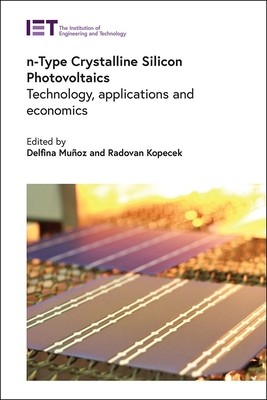
- We will send in 10–14 business days.
- Publisher: Institution of Engineering & Technology
- ISBN-10: 1839531762
- ISBN-13: 9781839531767
- Format: 15.6 x 23.4 x 2.2 cm, hardcover
- Language: English
- SAVE -10% with code: EXTRA
N-Type Crystalline Silicon Photovoltaics (e-book) (used book) | bookbook.eu
Reviews
Description
Most solar cells currently in commercial use are p-type solar cells, due to their historically lower cost and ease of manufacture compared to n-type solar cells. However, due to improved manufacturing technology and falling cost in general, the cost difference between the two types has shrunk, making n-type solar cells an attractive option for future commercial high-efficiency solar cells.
n-type solar cells are less prone to light-induced degradation, and are also less affected by iron impurities. This makes n-type solar cells more efficient compared to their p-type counterparts, with efficiencies of up to 25% being feasible in production.
Challenges in the manufacturing process and regarding degradation still remain to be solved, in order to realise n-type solar cells' full potential. The challenges, solutions and opportunities afforded by n-type solar cells are explored in this volume.
This book conveys current research and development for n-type solar cells and modules. With a systematic build-up, chapters cover the base material, wafer production, and the cell concepts including recent passivation techniques. Also covered are the related issues of solar module technology, such as encapsulation and interconnection, and degradation process management, including comparisons with p-type solar cells. In addition, economic and ecologic aspects and cost modelling are addressed.
This thorough, concise reference is a valuable resource for researchers from industry and academia working in the field of photovoltaics.
EXTRA 10 % discount with code: EXTRA
The promotion ends in 20d.10:08:30
The discount code is valid when purchasing from 10 €. Discounts do not stack.
- Publisher: Institution of Engineering & Technology
- ISBN-10: 1839531762
- ISBN-13: 9781839531767
- Format: 15.6 x 23.4 x 2.2 cm, hardcover
- Language: English English
Most solar cells currently in commercial use are p-type solar cells, due to their historically lower cost and ease of manufacture compared to n-type solar cells. However, due to improved manufacturing technology and falling cost in general, the cost difference between the two types has shrunk, making n-type solar cells an attractive option for future commercial high-efficiency solar cells.
n-type solar cells are less prone to light-induced degradation, and are also less affected by iron impurities. This makes n-type solar cells more efficient compared to their p-type counterparts, with efficiencies of up to 25% being feasible in production.
Challenges in the manufacturing process and regarding degradation still remain to be solved, in order to realise n-type solar cells' full potential. The challenges, solutions and opportunities afforded by n-type solar cells are explored in this volume.
This book conveys current research and development for n-type solar cells and modules. With a systematic build-up, chapters cover the base material, wafer production, and the cell concepts including recent passivation techniques. Also covered are the related issues of solar module technology, such as encapsulation and interconnection, and degradation process management, including comparisons with p-type solar cells. In addition, economic and ecologic aspects and cost modelling are addressed.
This thorough, concise reference is a valuable resource for researchers from industry and academia working in the field of photovoltaics.


Reviews